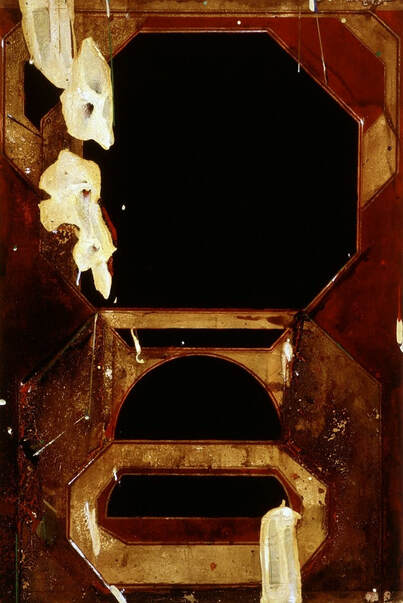Selected Reviews
Andrew Young
Artweek, December 12, 1991
- Paul Vest
Dorothy Goldeen Gallery, Santa Monica
The discord of a dialectic between two forcefully opposing viewpoints have, in the event of their union, a tendency to make a dynamic syntax—a lively narrative. On one hand, Andrew Young’s paintings pursue the consideration of a belief system based on the idea that the world is essentially organic in form, and is best expressed by an organically inspired imagery. In contrast, then, they speak of a belief based on the concept that the world consists of a highly ordered interaction of things and, therefore, maybe more suitably conveyed through geometric structure.
The discord of a dialectic between two forcefully opposing viewpoints have, in the event of their union, a tendency to make a dynamic syntax—a lively narrative. On one hand, Andrew Young’s paintings pursue the consideration of a belief system based on the idea that the world is essentially organic in form, and is best expressed by an organically inspired imagery. In contrast, then, they speak of a belief based on the concept that the world consists of a highly ordered interaction of things and, therefore, maybe more suitably conveyed through geometric structure.
|
By means of painterly discourse, Young seems to be making a plea for a continuation of dialogue about formal aesthetic issues. Of primarily import, these paintings tell of the differences between the given values of percept versus concept, and of the visual contrast between the use of a free form imagery along side a strict, geometrically structured pictorial system. Young’s acknowledgement of the persuasiveness of these differing points of view—and his respect for both of them—would seem to present the dilemma on how to unite them—in effect, how to integrate, by means of illustration, such disparate notions, in order to convey the essence of reality into a unified, picturable whole? The classic and contemplative nature of his paintings attest to his success.
Although Young’s work is not similar visually to either Kandinsky or Mondrian he does share and respond to their handling of the organic-geometric issue. Like Kandinsky, Young does not commit himself to a purely organic or geometric art; in part, he shares Kandinsky’s rebuttal to commitment to either ideology. And Young, like Kandinsky, does not suffer from the anxiety of the search for a choice in the matter. Mondrian also pooled the two eloquently. For Mondrian, however, that work was done during a period of transition which eventually led to his highly ordered geometric paintings. Young out flanks any real or implied necessity of a commitment to either by functioning as a gatherer and utilizer. Through the aid of a labyrinth of art-historical reference material, Young in effect positions himself as a neutral messenger who expresses the virtues of controlled but free-reigning investigations into artistic matters. |
Jewels Upright, 1991
Egg tempera on wood panel, 34.5 x 23.25 in. Wolfgang Drechsler Collection. |
The provocative and highly nuanced surfaces of these paintings signal a multitude of practices from past and present painting. Past is linked to present by a revival of an ancestral practice of egg tempera on wood panels. The severe cracking and alligator-like texture in select areas unmistakably recalled the aged condition of Renaissance-era work.
Young employs layers of mixtures of varying amounts of varnish and solvent to create a chemical/physical reaction, which causes the surfaces of his paintings to crack—a technique to accelerate the aging process. The sense of a time-worn artifact transports the viewer through a historic chronicling of artistic endeavors, and the work recalls artists as diverse in time and manner as Lorenzetti and Manet. Young’s attention to process carries hints of the New York school of painters, but the pictures also evoke traditional floral and still life imagery through to Russian Suprematism. Collectively, they carry a vast amount of visual information, held within the reserve scale of Young’s format.
Young employs layers of mixtures of varying amounts of varnish and solvent to create a chemical/physical reaction, which causes the surfaces of his paintings to crack—a technique to accelerate the aging process. The sense of a time-worn artifact transports the viewer through a historic chronicling of artistic endeavors, and the work recalls artists as diverse in time and manner as Lorenzetti and Manet. Young’s attention to process carries hints of the New York school of painters, but the pictures also evoke traditional floral and still life imagery through to Russian Suprematism. Collectively, they carry a vast amount of visual information, held within the reserve scale of Young’s format.
